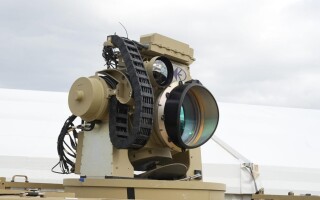Discrete vs distributed: Transforming military training and simulation systems
StoryOctober 20, 2016
Advances such as augmented reality and virtual reality (AR/VR) are redefining expectations of quality and performance in increasingly diverse military training scenarios. These improvements also demonstrate the need for a philosophical change in system design strategy as system engineers prepare for the next generation of "training as a service." Developers must move away from discrete systems and toward more distributed training environments that are capable of delivering point-of-need training via a single synthetic training environment.
The U.S. Army’s Program Executive Office for Simulation, Training, and Instrumentation (PEO STRI) has called for industry support in defining “leap ahead and disruptive” technologies that will enable the Synthetic Training Environment (STE). The office wants guidelines for the technologies to create impact now and poise itself for continued evolution over the next several decades. The goal of the STE is to deliver training as a service, using connected technologies to more effectively reach the point of need. According to the PEO STRI, training applications must be modular, composable, scalable, and service-oriented, with a focus on automation to reduce tech support. To respond competitively, designers must offer increasingly agile solutions for customized training on demand, while reducing intrinsic reliance on individual hardware components. This is no easy transition, and requires new thinking that embraces incremental system efficiencies where they offer performance and value.
To move incrementally toward a distributed environment, elements such as storage, compute processing, image rendering, display, and network architectures should be considered as building blocks (Figure 1). These building blocks must be critically evaluated against needs for mobility, content delivery, and security, in order to align a design vision with the new realities of distributed training. An incremental approach has significant value in this effort – demonstrated here by distributed options for storage and image rendering, and their impact on mobile training applications.
Figure 1: Elements such as storage, compute processing, image rendering, display, and network architectures should be considered as building blocks and must be critically evaluated against needs for mobility, content delivery, and security. Graphic courtesy Distributed Computing.
Driving change with distributed storage
Shifting from discrete to distributed storage demands a fundamental change in design philosophy, considering the role of storage as a content hub for live, virtual, constructive (LVC) training rather than as a piece of hardware (Figure 2). This view not only establishes a more global outlook for training systems, but it also ensures that developers have the ability to more easily adapt over the next several years of simulation development. Speed and scalability are central to this shift, addressing integration, interoperability, and composability as the three primary pillars of LVC. The key for designers is to create a foundation capable of supporting these requirements across the spectrum of training, from desktop or instructor-led training all the way up to immersive, full-mission simulation.
Figure 2: Distributed designs are capable of connecting more simulation devices to a single, centralized database without slowing the system down, even while scaling to accommodate varying requirements for multiple users. Graphic courtesy Distributed Computing.
Software-defined storage is one way to deliver this value, as it eliminates the focus on underlying hardware and instead allows designers to focus on adaptable, workload-optimized performance. In the software-defined model, storage systems are virtualized, pooled, aggregated, and delivered to users as a software service; this model offers longer life cycle and lowers operating expense and total cost of ownership over time.
Designers using the software-defined model are able to factor in a flexible range of on-demand performance requirements, tailoring distributed solutions based on various network or connected architectures. Adaptability becomes inherent, adding critical value to military training initiatives as the number of displays, array of simulators, and types of data needs change over time.
Redefining compute and rendering
These changing needs necessitate a case-by-case evaluation – managing displays, considering the types of images to be rendered, and recognizing where distributed environments can can be used in the future, whether or not they apply today. Solutions must be tailored from both a compute and storage perspective, pertaining specifically to the type of content and its delivery method. This model considers rendering as just one of many types of content, and provides the opportunity to create a flexible, scalable, and reusable structure that enables distributed content delivery.
A multitiered building block approach is required, one that breaks down the distributed network-training infrastructure into various layers, including network execution modeling, decisions, and higher-level collaboration. For example, the end goal may be to create a “rendering farm,” or centralized rendering capacity that can be used at any given time by any given client. Significant architecture changes must take place in the subsystems to support this vision: One subsystem may be the rendering farm itself, while another is the software architecture-enabling specific data to be pulled client by client.
A relatively minor change to software architecture could be an interim step, enabling image rendering to move out of the big box assembly and operate closer to the display. Such a step is a move away from the “Big Iron” focus on systems – technology can be reused more easily as applications and their performance requirements evolve, and costs related to transmitting rendered images over long distances are reduced. Ultimately, resources are then freed to focus on the rendering farm in the next incremental step, demonstrating a multitiered approach that progresses toward a more centralized distributed environment.
Distributed impact on mobile training and simulation
At first glance, centralized mobility seems to be an oxymoron, in that centralized systems are located in one place and therefore not mobile. However, building blocks such as centralized storage and image rendering actually help create mobility for the user and in the development of training itself. System performance does not require data from multiple locations and users can instead access point-of-need training from a single source; training instructors can access the same centralized infrastructure to make application changes and improvements in real time.
Centralized technology is the driving factor for mobile systems to capitalize more fully on AR/VR applications, which currently exist but are limited by discrete systems (Figure 3). Distributed systems can add new value by enabling point-of-need training that is more immersive for users in multiple locations, such as full mission simulators capable of blending virtual reality with synthetic environments.
Augmented reality may hold even greater potential from a mobile perspective, enabling fully networked, architected systems that train users via an actual real-world device. Instead of investing in training a soldier to handle aircraft inspections supported by procedural manuals or other types of instruction materials, the experience is redefined using system data from flight logs, checklists, or electronic flight bags. Coupled with a head-mounted display (HMD), the trainee executes the aircraft training protocol, and is supported by data such as the last time the aircraft was serviced, schematics, and step-by-step instructions on how to perform a specific service. Military programs can capitalize on the same distributed platform for soldiers training off-site, working in the field, engaged in battle, or handling routine maintenance of equipment and systems.
Figure 3: Mobility is one more layer of reality in terms of how the simulation system feels and acts for the trainee, more closely mirroring a real-life operational environment. Trainers benefit as well, gaining a greater level of global access to resources and users through a mobility infrastructure. Image courtesy Distributed Computing.
Distributed training and simulation moving forward
Mandated by PEO STRI, the training and simulation industry is moving toward solving the same old problem of how to enable interoperability and connectivity to effectively improve end-user proficiency in complex, evolving training scenarios. Current thinking forces designers to “back into” solutions, working around limitations instead of looking forward to where both the industry and military-training demands are heading.
Instead, by taking incremental steps using a building-block approach, the simulation and training industry can achieve its long-term goals of reducing footprint and operational costs. Distributed solutions – illustrated by ideas like software-defined storage and new architectures for image rendering – also ensure performance beyond a hardware-based life cycle. This approach can have a tangible benefit for the military-procurement community, as the application’s life cycle is solely determined by how long it is needed.
Establishing new ways of presenting information – flexible, scalable, and repeatable for long-term deployment and technology evolution – enables trainers to zero in on how to manage change without changing entire infrastructures. It’s a break from hardware limitations, a move toward training as a service, and another major transformation for global military forces preparing for increasingly diverse threats and missions.
Sidebar 1
Mike Pape is director of training and simulation solutions, Dedicated Computing. The company’s training and simulation solutions combine hardware, software, and services in the pursuit of advancing the skills of the warfighter. He earned an MS in management from Cardinal Stritch University and a BS in electrical and computer engineering and mathematics from Marquette University. Readers may contact Mike at [email protected].
Dedicated Computing www.dedicatedcomputing.com










